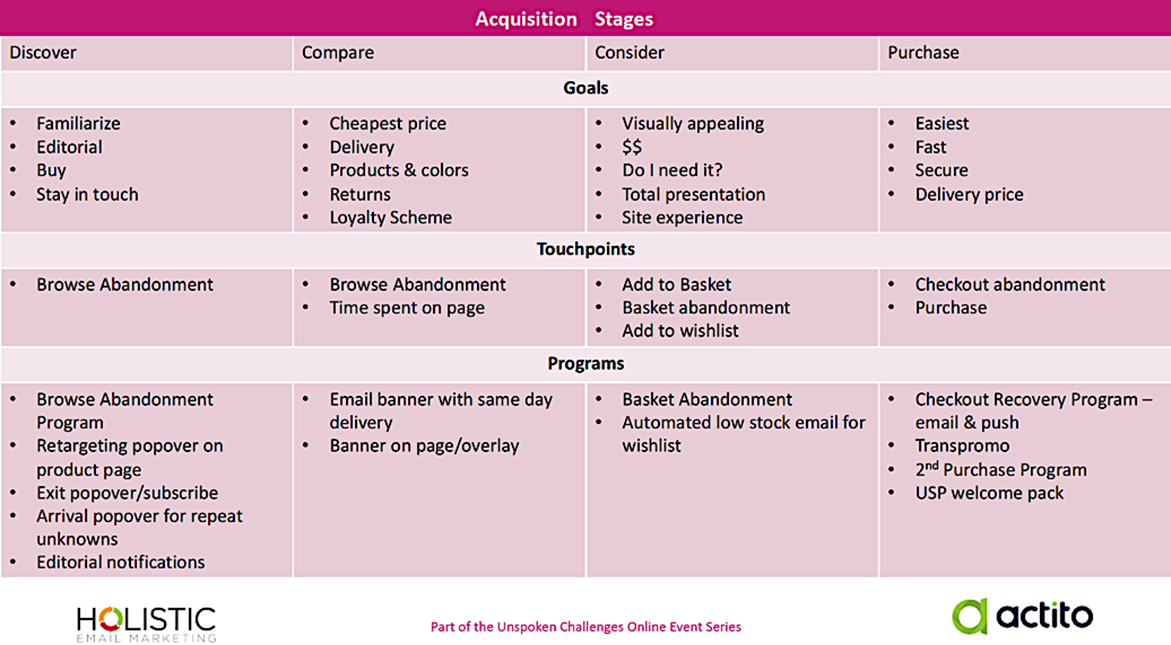Overcome the 3 Challenges to Successful Journey Mapping
Customer journey mapping helps you understand how your customers interact with your brand and website. But it has another use as well – setting up useful and relevant automated messages.
Journey mapping has also proved to be one of the biggest challenges many of my clients face. The whole process needs to be demystified so we can make better use of it to know our customers and serve their needs better.
Good journey mapping takes time, a multi-team approach and the deft application of data in the right places. Most marketers face three major challenges when they attempt journey mapping for the first time:
Challenge 1: Fear of the unknown
Knowing where to start can be your biggest obstacle at first. If you've never done anything like an email or web audit, you might feel as if you're starting out blind. These five guideposts will help you stay on track:
Stay focused on your customer: Journey mapping is all about your customers – their goals, their objectives, their obstacles. Don't approach it as a marketer or as a brand advocate.
This means you must know your customers as intimately as you can. Who are they? How do they find and engage with your brand? Where do they usually begin? Where do they drop off? What can you do to help them move on? These are the engagement points where you can gain the most fruitful information.
Identify as many journeys as you can. Journey mapping isn't a monolith. It's made up of a network of smaller journeys – a welcome and onboarding, abandonment, win-back and many more.
Start with the obvious ones, such as the journey from a PPC ad to your home page, or an email click to a product page. Audit these journeys – where people go first, where they go next, where they go after they hit your landing page from an organic search, when they leave your site.
If you're just starting out with journey mapping, start out small. It's easy to get overwhelmed with all of the work that goes into mapping. As with any new program, begin with the basics and use what you learn from testing and implementation to build on it for the next stage.
Think about how to optimize those journeys. Naturally, not every customer follows the same path, but you should be able to identify the broad strokes that most customers are likely to take.
Review all of your data – site as well as email. Bounce rate, for example, can be quite illuminating because they can indicate where people run into obstacles. With data like this, you can start looking for ways to optimize your journeys.
Use a combination of teams and tools: Journey mapping doesn't have a single source of truth. Involve as many teams as you can to get a holistic view of your customers. Bring in your web and retention teams and other voices to brainstorm, audit your processes and ask questions.
After you gather all your data sources, you can start creating your journey map. This is where all that data research will pay off.
For the planning process, go hands-on! Pull out your markers and sticky notes, whiteboards and giant poster sheets you can tack to the walls. Then synthesize all your learnings with a software program like Lucidchart to create the maps themselves.
Don't take shortcuts: Mapping the journey is the end of the process, not where you start. Explore and research your data to understand your customers and their needs, what's working in the journey and what isn't.
The example below was the outcome of a client Journey Mapping workshop, in which we break down the Acquisition journey into four sub-stages: Discover, Compare, Consider and Purchase.
Each sub-stage also has its own goals, touchpoints and programs.

This exercise can help you see where you can map touchpoints and pair them with messages that help keep customers moving on the journey toward their goals and then continue the journey for other Lifecycle stages.
These would include Conversion, Retention and Win-Back, each of which has its own unique sub-stages.
If you start with your customers' goals (again, not your own goals) and the touchpoints they come across in each journey stage, you'll see where a well-timed abandonment program can kick in. Or maybe a retargeting offer on a product page would be more effective. This is when you can start focusing on tactics like these – not before.
Challenge 2: Starting at the wrong place with automation programs
Now you've finished your research page and mapped out your journeys. It's time to identify the automation programs you can use to address those touchpoints.
This phase is where most marketers begin the mapping process – with tactics like abandonment programs, acquisition forms and the link. You can easily go wrong here because you don't have the data that you would have collected about your customer, their goals, their objections, needs and wants.
When you begin with tactics, you're implementing them on an ad hoc basis. You aren't looking at the bigger picture or what your customers need. You're coming up with a program that you think might work or that worked for somebody else. That disconnect can lead to disastrously inaccurate messaging.
You need to implement a program that addresses your customers' challenges and barriers to conversion. That's what makes true journey mapping so powerful. It's not an overnight process.
Your journey map shows where your customers came from, where they go, what they do, which pages they visit. Naturally, not every customer will follow the same journey from start to finish. Instead, you're mapping out the most popular routes covered. You can always build on a basic map to cater to customers who take shortcuts to reach their goals.
Once you set your basic map of the journeys taken, you can begin planning out each program in detail. When you combine them as part of a customer journey, you see how each program interconnects with and relates to the others. This helps you understand what your customers are experiencing and how to manage a potential flood of messages.
If a customer is already in one program, such as an onboarding/first-purchase series, what happens if they abandon a cart? Could they end up getting both onboarding emails and abandonment reminders at the same time? That's a potential turn-off.
By mapping back to the journey, you can see where you might need to pause one journey while another one completes, dial back promotional campaigns or just let the emails roll out.
Challenge 3: Failing to optimize automated programs
Optimizing means continually testing your automated programs. This is why I advise starting small and basic with your mapping process and building up programs over time.
A/B split tests are ideal for testing your automations. Don't skip this step! Your automated programs are usually the best-converting emails you can send when you do them right. And even if you don't do them all right, testing shows you where you can refine and improve them.
You could split test each email in a first-purchase or onboarding message stream, but you'll get more useful learnings if you test an entire messaging stream against another. Here's how:
- Write a hypothesis that outlines what you think you'll learn, such as "We believe that a message stream emphasizing benefits will convert better than a stream that stresses savings."
- Create a complete message stream for each variable in which each email supports the theme; here, benefits versus savings.
- Launch the test and log the results.
- Review your findings and choose your winner. Then, come up with another hypothesis and start the process over again, replacing the losing stream, with the winning stream as the control. This is how you build continuous testing – and continuous optimization – into your workflow.
5 sticky notes to post where everybody can see them
It's easy to get bogged down in numbers and processes as you research, build and test your customer journey maps and automation programs. These reminders can help you stay on task, in the groove and out of the weeds:
1. Don't get overwhelmed.
Starting the process is hard. Bring in other people to share the burden. Don't try to do it all at once. Start small and build on what you learn.
2. Think like your customer.
We always say the marketer is not the customer, but mapping requires you to put your own views and biases aside and think about what the customer wants to do, not what you want them to do.
3. Always ask, "How can we help?"
That's the first question an effective salesperson asks. Look at obstacles and see what you could do to help customers solve them.
4. Strategy before tactics.
Tactics are easy. Strategy takes more thought. But if you do your research, the results will reveal the strategy to you.
5. Always be optimizing.
Build continuous testing into each automation program, and use what you learn to refine and improve every phase of it.
Note: My post is based on a webinar series hosted by my company, Holistic Email Marketing, and the marketing automation and messaging platform Actito. Watch the full presentation for free on YouTube to learn how to translate your journey map into marketing automation programs. If you'd like to see the presentation decks, just drop me a line at kath@holisticemail.com.

Photo by Vlad Bagacian on Unsplash

 How to resolve AdBlock issue?
How to resolve AdBlock issue? 